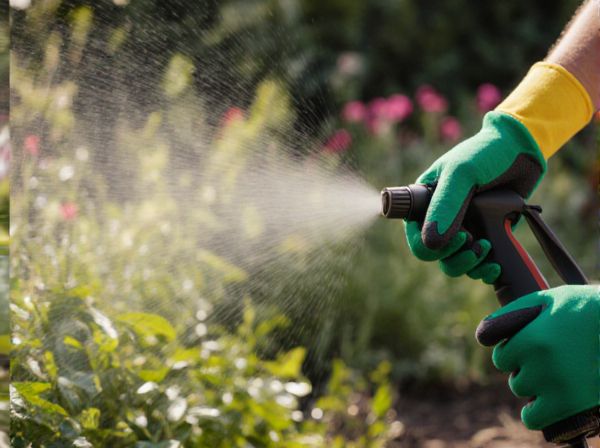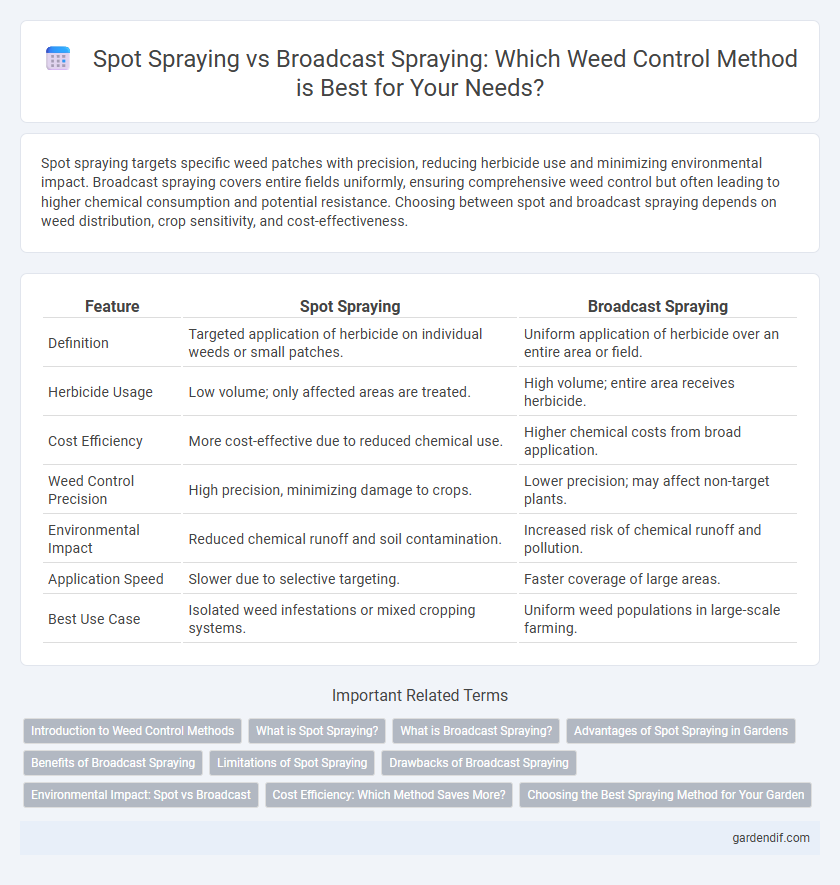
Spot spraying vs broadcast spraying Illustration
Spot spraying targets specific weed patches with precision, reducing herbicide use and minimizing environmental impact. Broadcast spraying covers entire fields uniformly, ensuring comprehensive weed control but often leading to higher chemical consumption and potential resistance. Choosing between spot and broadcast spraying depends on weed distribution, crop sensitivity, and cost-effectiveness.
Table of Comparison
| Feature | Spot Spraying | Broadcast Spraying |
|---|---|---|
| Definition | Targeted application of herbicide on individual weeds or small patches. | Uniform application of herbicide over an entire area or field. |
| Herbicide Usage | Low volume; only affected areas are treated. | High volume; entire area receives herbicide. |
| Cost Efficiency | More cost-effective due to reduced chemical use. | Higher chemical costs from broad application. |
| Weed Control Precision | High precision, minimizing damage to crops. | Lower precision; may affect non-target plants. |
| Environmental Impact | Reduced chemical runoff and soil contamination. | Increased risk of chemical runoff and pollution. |
| Application Speed | Slower due to selective targeting. | Faster coverage of large areas. |
| Best Use Case | Isolated weed infestations or mixed cropping systems. | Uniform weed populations in large-scale farming. |
Introduction to Weed Control Methods
Spot spraying targets specific weed infestations with precise herbicide application, minimizing chemical use and environmental impact. Broadcast spraying uniformly distributes herbicides over large areas, effective for widespread weed control but increasing the risk of non-target damage. Choosing between spot and broadcast spraying depends on infestation scale, weed species, and environmental considerations to optimize weed management strategies.
What is Spot Spraying?
Spot spraying targets specific patches of weeds using precise application equipment, minimizing herbicide use and environmental impact compared to broadcast spraying. This method increases efficiency by focusing on visible weed infestations rather than treating the entire area indiscriminately. Advanced technologies like GPS and sensor-based sprayers enhance spot spraying accuracy, reducing chemical waste and promoting sustainable weed management.
What is Broadcast Spraying?
Broadcast spraying involves applying herbicides evenly over an entire field or area, targeting all vegetation regardless of weed presence. This method ensures comprehensive coverage, making it effective for controlling widespread weed infestations in crops like corn, soybeans, and wheat. Broadcast spraying can reduce labor costs but may increase herbicide usage compared to more selective techniques like spot spraying.
Advantages of Spot Spraying in Gardens
Spot spraying in gardens targets weeds precisely, reducing herbicide use by up to 90% compared to broadcast spraying, which treats entire areas indiscriminately. This method minimizes damage to desirable plants, preserving garden health and biodiversity. Cost efficiency and environmental safety are enhanced due to lower chemical runoff and reduced impact on beneficial insects.
Benefits of Broadcast Spraying
Broadcast spraying ensures uniform herbicide coverage across the entire field, effectively controlling weed populations before they establish. This method allows for faster application over large areas, reducing labor costs and improving operational efficiency. Enhanced weed control from broadcast spraying can lead to increased crop yields and better long-term soil health by minimizing weed seed dispersal.
Limitations of Spot Spraying
Spot spraying limits herbicide application to targeted weed patches, reducing chemical use but struggles with detecting small or dispersed weed populations, leading to incomplete control. This method demands high-precision technology and accurate mapping, which can increase operational costs and complexity. Spot spraying may be less effective in dense or mixed weed infestations where broadcast spraying ensures uniform coverage and quicker treatment.
Drawbacks of Broadcast Spraying
Broadcast spraying often leads to excessive herbicide use, increasing environmental contamination and the risk of weed resistance. This method lacks precision, resulting in unnecessary damage to non-target plants and higher operational costs. Inefficient coverage in broadcast spraying can cause inconsistent weed control, reducing overall effectiveness compared to targeted spot spraying.
Environmental Impact: Spot vs Broadcast
Spot spraying targets specific weed patches, significantly reducing herbicide use and minimizing chemical runoff into surrounding ecosystems. Broadcast spraying disperses herbicide over entire fields, increasing the risk of contamination in soil and water sources and harming non-target plants and beneficial insects. Reducing chemical volume through spot spraying supports biodiversity and promotes sustainable weed management practices.
Cost Efficiency: Which Method Saves More?
Spot spraying targets specific weed-infested areas, reducing herbicide usage and lowering overall chemical costs compared to broadcast spraying, which treats entire fields regardless of weed presence. Studies show spot spraying can cut herbicide expenses by up to 50%, making it more cost-effective for patchy weed infestations. However, broadcast spraying may save labor costs in large, uniformly weeded fields despite higher chemical inputs.
Choosing the Best Spraying Method for Your Garden
Spot spraying targets specific weed areas, reducing herbicide use and minimizing environmental impact, making it ideal for smaller gardens or isolated weed patches. Broadcast spraying covers entire surfaces uniformly, offering faster application and effective control in large or heavily infested gardens but increases risk of damage to desirable plants. Evaluate garden size, weed density, and plant sensitivity to select the most efficient and eco-friendly spraying method.
Spot spraying vs broadcast spraying Infographic

 gardendif.com
gardendif.com